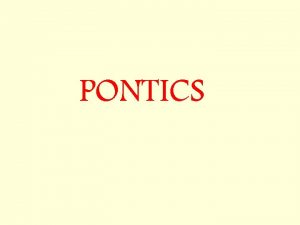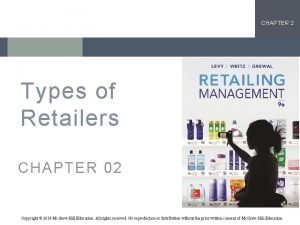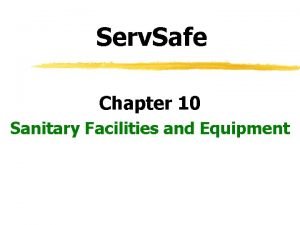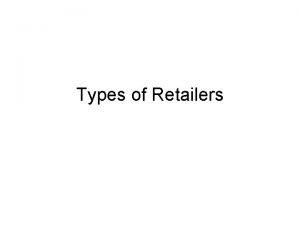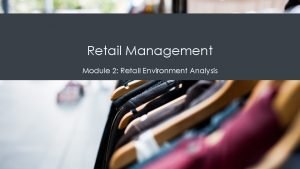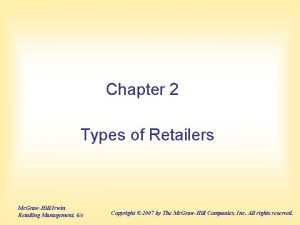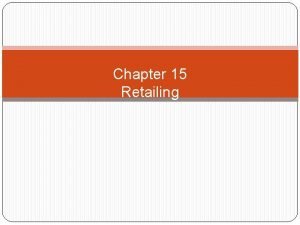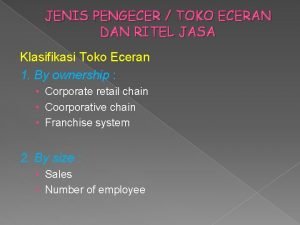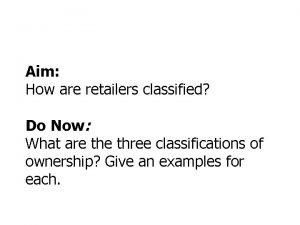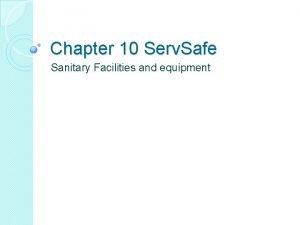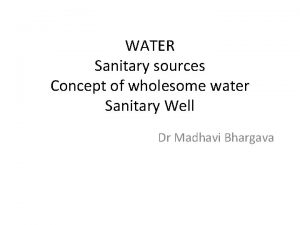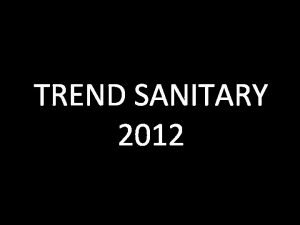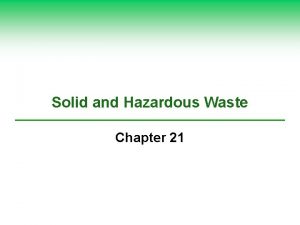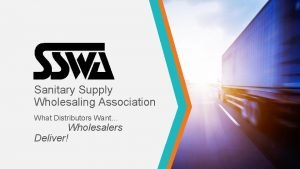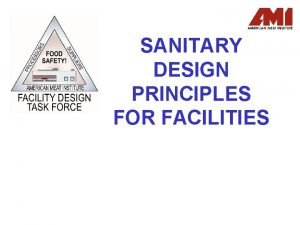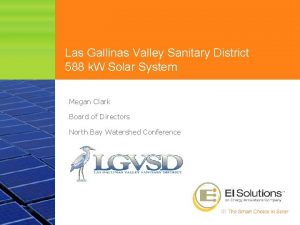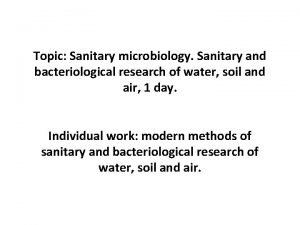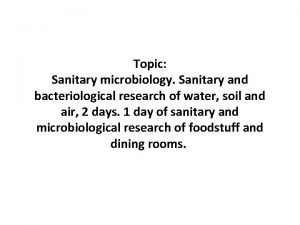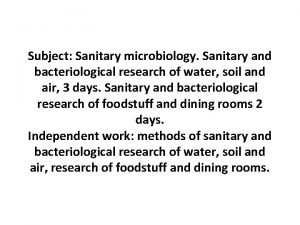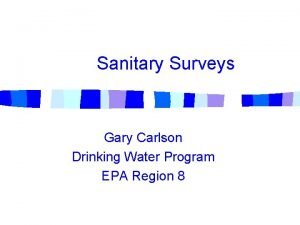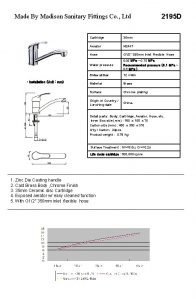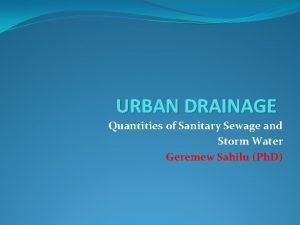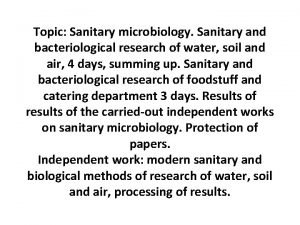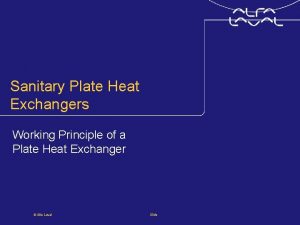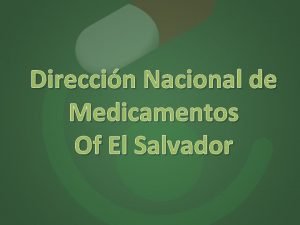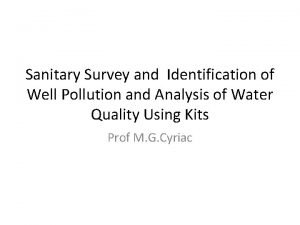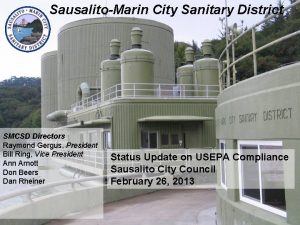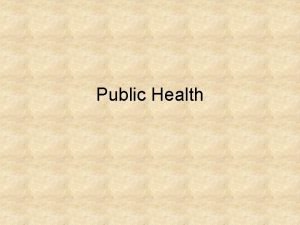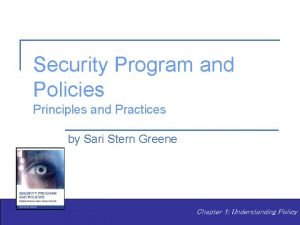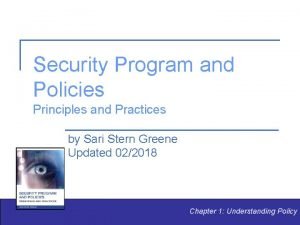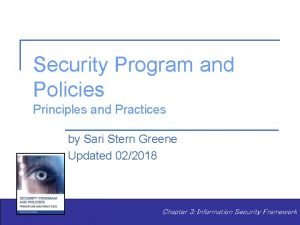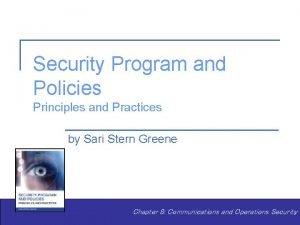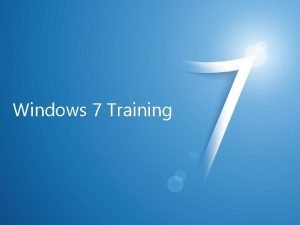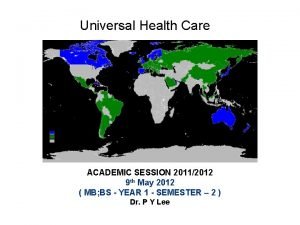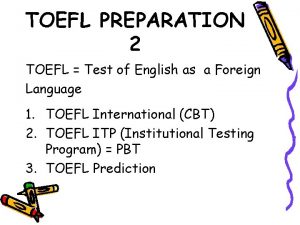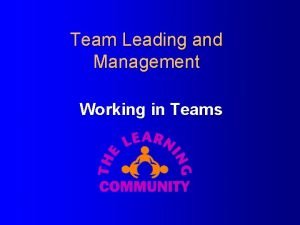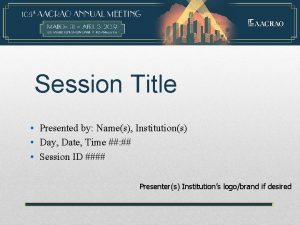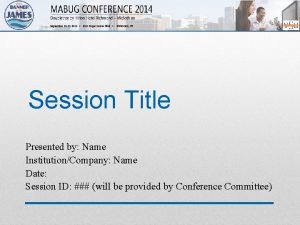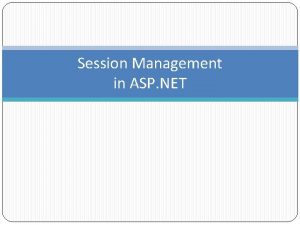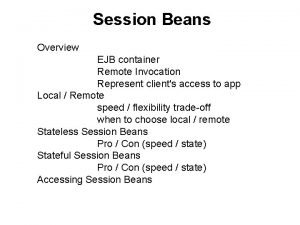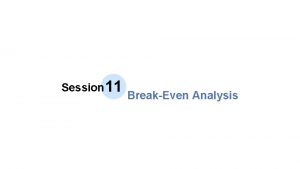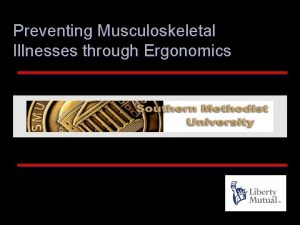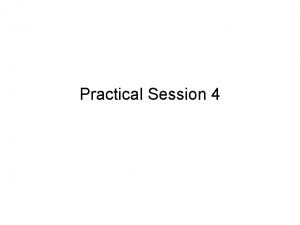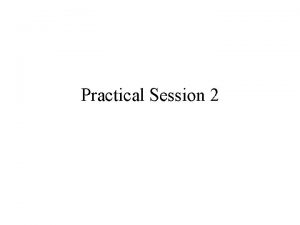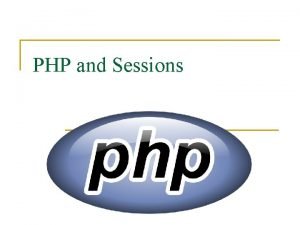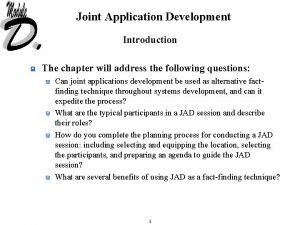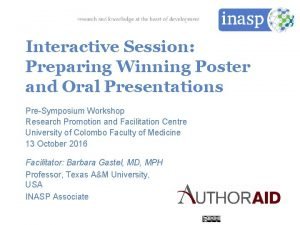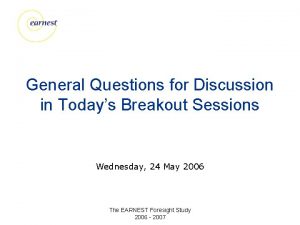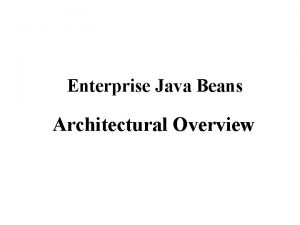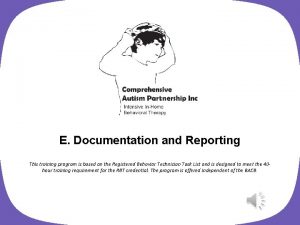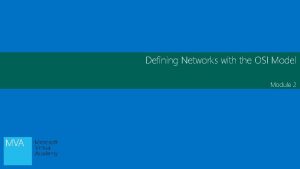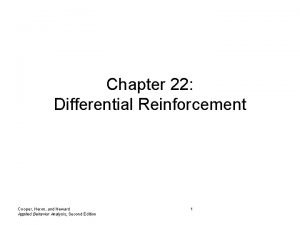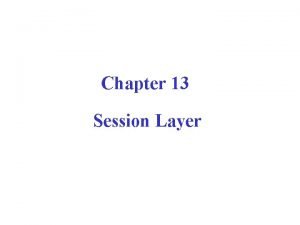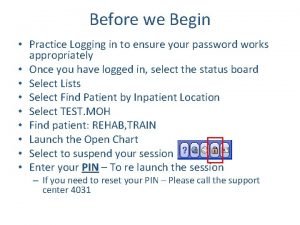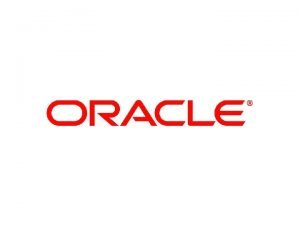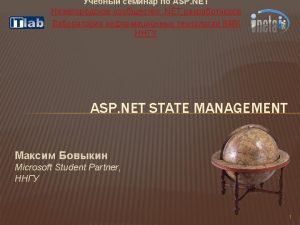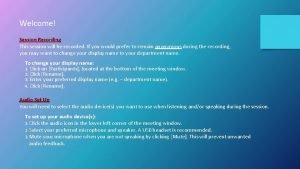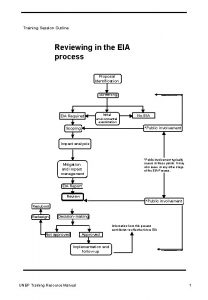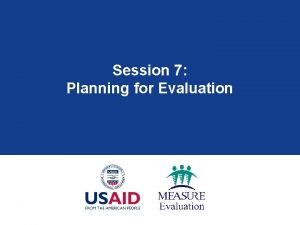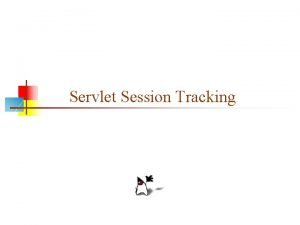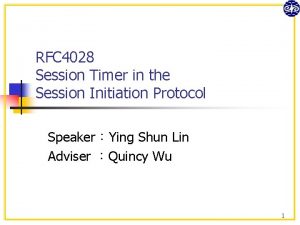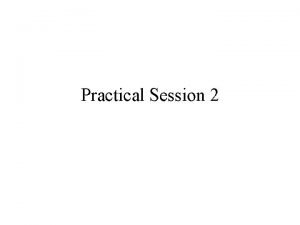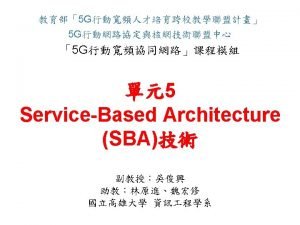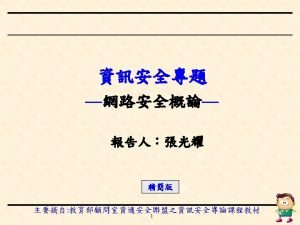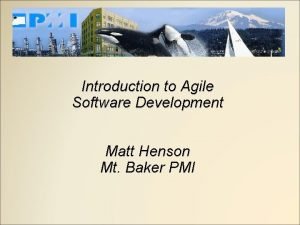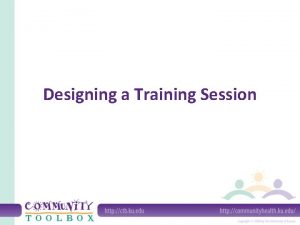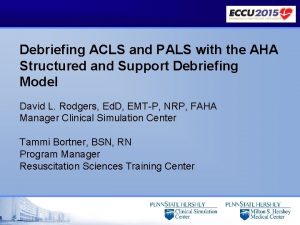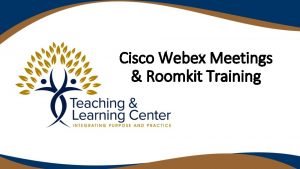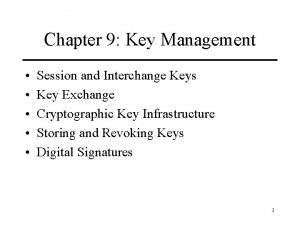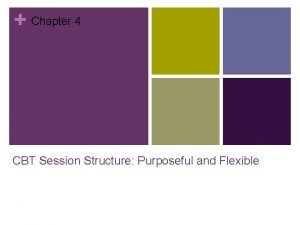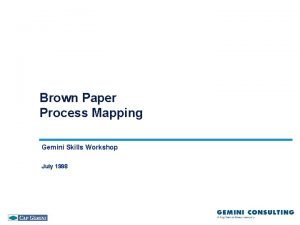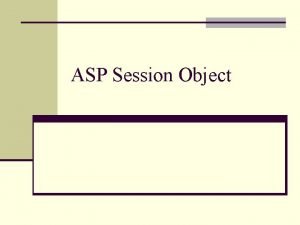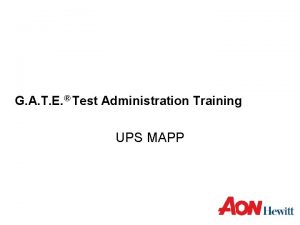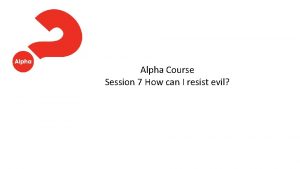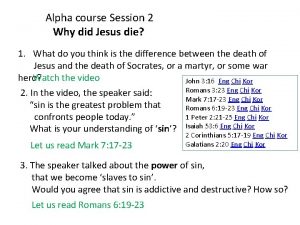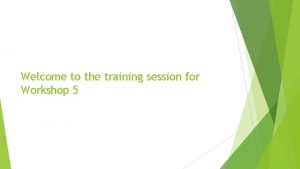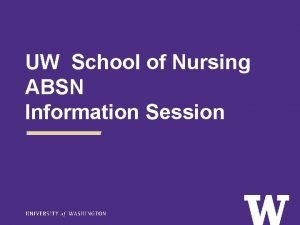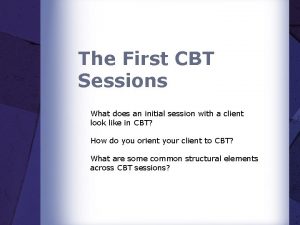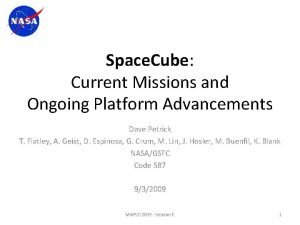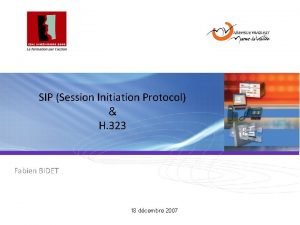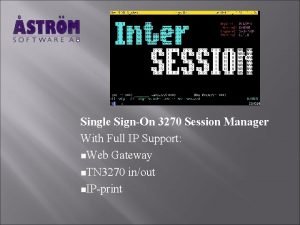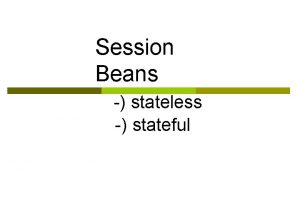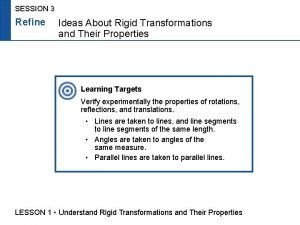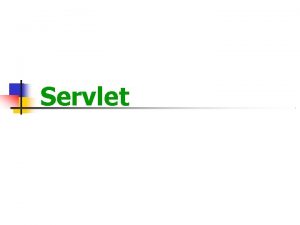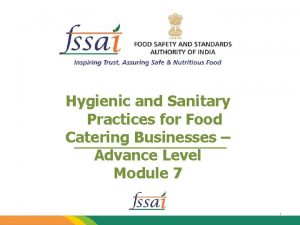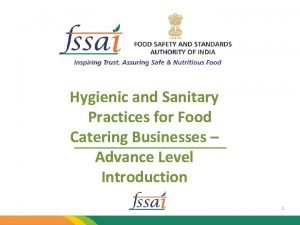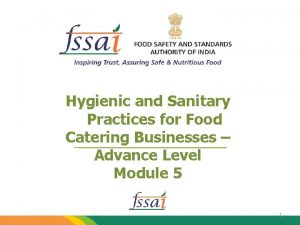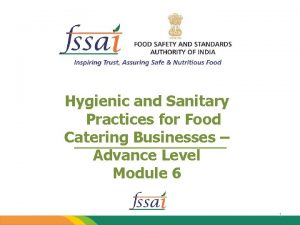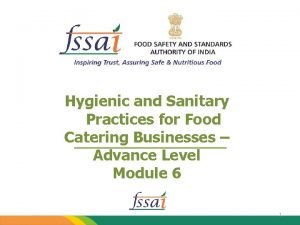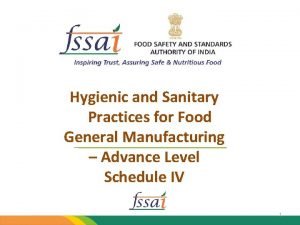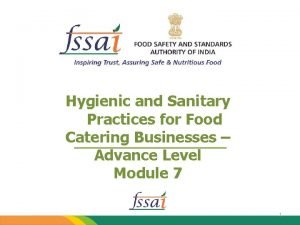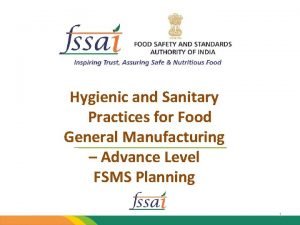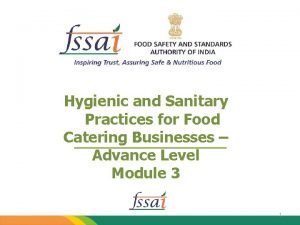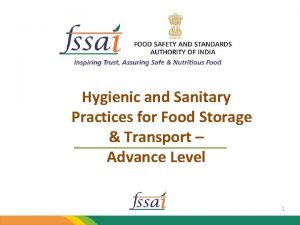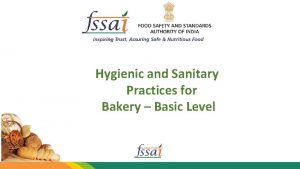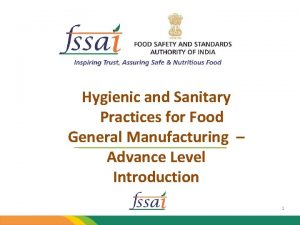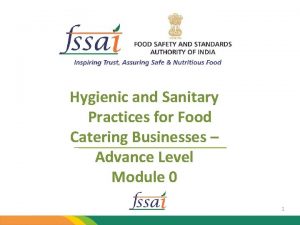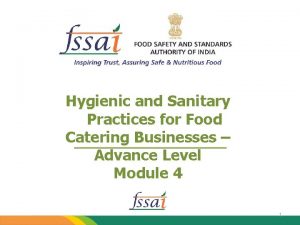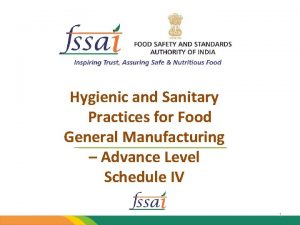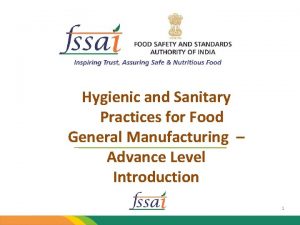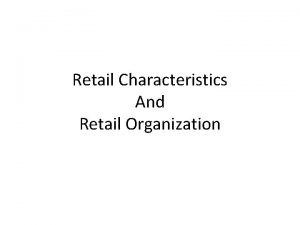Hygienic and Sanitary Practices for Retailers 1 Session

























































































































































































- Slides: 185

Hygienic and Sanitary Practices for Retailers 1

Session 1 Advance Level Introduction 2

Introduction to Food Safety • Food Safety means assurance that food is acceptable for human consumption according to its intended use. • Food Safety Management System means the adoption Good Manufacturing Practices, Good Hygienic Practices, Hazard Analysis and Critical Control Point and such other practices as may be specified by regulation, for the food business. 3

What is FSMS as per FSSAI • FSS Act 2006 defines Food Safety Management System (FSMS) means the adoption Good Manufacturing Practices, Good Hygienic Practices, Hazard Analysis and Critical Control Point and such other practices as may be specified by regulation, for the food business. • For the purpose of this document and all assessments conducted there under, the definition of FSMS shall be read as the above and the requirements for this be taken as that defined under Schedule IV & Critical Control Point.

FSMS Program Based on FSSA Schedule 4 Compliance FSMS Plan FSMS Program

Schedule IV 1. Why? Section 16 of the FSSA, holds FSSAI responsible for regulating and monitoring the manufacture, processing, distribution, sale and import of food so as to ensure safe and wholesome food. 1. How? By introducing basic hygiene and safety requirements in the form of Schedule IV 1. Where in FSSR? The Schedule IV has been mandated for compliance by introducing it as a licensing requirement/condition under the Food Safety and Standards (Licensing and Registration of Food Businesses) Regulations, 2011.

Where does it impact? F i l i n g A p p l i c a t i o n 1 U n i q u e A p p l i c a t i o n N u 2 m b e P r o v i d i n g A d d i t i o n a l R e q 3 u i r 5 I n s p e c Insp t ectio i n of o Pre n mise R e p o r t 4 E i t h e r g r a n t o r r e j e c t a p p 6 l i c

Non-conformance may lead to 1. Under FSS (Licensing and Registration of Food Businesses) a) Notice/ rejection of application during inspection for licensing b) Notice/cancellation of license during periodic food safety audit by the Licensing Authority 2. Under Section 56 of FSSA a) Penalty of up to Rs one lakh for unhygienic or unsanitary processing or manufacturing of food under

Introduction to Food Safety Hazard - biological, chemical or physical agent in food, or condition of food, with the potential to cause an adverse health effect. Physical Chemical Food Hazards Biological Allergens 9

Introduction to Food Safety Physical Hazards Any foreign object (inanimate) found in the food or a naturally occurring object (bone in fillet), that poses; a hazard is called a ‘Physical Contamination’. Common Physical Hazards include : Glass Chipped pieces of cutlery and crockery Metal shavings from cans and foils Stapler pins Blades Plastic films used for wrapping or chipped pieces of disposables Lint and threads Band- aids Hair Finger nails Bones Jewellery pieces 10

Introduction to Food Safety Chemical Hazards Naturally occurring and Process Induced Chemical substances that can cause a food borne illness is called a ‘Chemical Contaminant or Hazard’. Process Induced Chemical Contaminants include : - Toxic metals in the catering set up or supply chain - Pesticides, Colorants - Cleansing products and sanitizers - Equipment lubricants - Chemical Food Additives, Preservatives - Packaging materials-migration of residues from packaging material to oil. - Adulteration with other oils or mineral oil Natural Chemical Contaminants include : - Allergens - Mycotoxins 11

Introduction to Food Safety Biological Hazards Biological hazards are organisms, or substances produced by organisms, that pose a threat to human health. They are a major concern in food processing because they cause most food borne illness outbreaks. Major biological hazards include – - Bacteria ex: Salmonella spp. , Enterohaemorrhagic Escherichia coli, Listeria monocytogenes, Staphylococcus aureus, Clostridium botulinum - Yeast & Mold ex: Candida, Aspergillus sp, Helicosporium 12

Introduction to Food Safety Biological Hazards causes 1. Food Borne Infections result when a person consumes food containing pathogens; which grow in the human intestine and cause discomfort or disease. Typical symptoms of a ‘food borne Infections’ do not appear immediately. 2. Food Borne Intoxications result when a person consumes food containing toxins in it; that cause discomfort or disease. Typical symptoms of a ‘food borne Intoxication’ appear quickly. 3. Food Borne toxin – mediated infections result when a person consumes food containing toxins produced by the pathogens in it; which grow in the human intestine and produce toxins that cause discomfort or disease. 13

Introduction to Food Safety Conditions favouring growth of Microorganisms Conditions FAT TOM Definition Food borne Microorganisms draw nutrients from Potentially hazardous foods Acidity Food borne Microorganisms grow well between the p. H range of most foods Temperature Microorganisms grow well between the temperature range of 5⁰C – 60⁰C, most commonly known as the ‘Danger Zone’ Time Microorganisms need sufficient time to grow; when exposed to the ‘Danger Zone’ Oxygen Microorganisms require oxygen in free or combined state; to favor their growth Moisture Microorganisms require moisture to grow and is measured in the form of ‘Water Activity (Aw)’ 14

Introduction to Food Safety ACTIVITY- 1 1. Food Hazards can be present in food when reduced to an acceptable level. True/False 2. All conditions & measures necessary to ensure the safety & suitability of food at all stages of food chain is a. Food Safety b. Food Hygiene c. Food Control d. Food Suitability 3. Microorganisms grow well between the temperature range of. . . . . , most commonly known as the ‘Danger Zone’. a. 7⁰C – 74⁰C b. 5⁰C – 74⁰C c. 5⁰C – 60⁰C d. 7⁰C – 60⁰C 4. Food Borne. . . result when a person consumes food containing pathogens. a. Infection b. Intoxication 5. Food borne Micro-organisms grow well between the p. H range of most foods. True/False 15

Introduction to Food Safety ALLERGENS 16

Allergens Cereals containing gluten Sulphite in concentrations Tree nuts and nut products of 10 mg/kg or more Allergens Crustacea and products of these Eggs and egg products Milk and milk products Fish and fish products Peanuts, soybeans and products of these 17

Allergen Management Allergies, Allergens & Food Handlers • What is the responsibility of an oil company in Allergen Management? • What is the responsibility of the Food handler in Allergen Management? • What is the consumers responsibility in Allergen Management? 18

Foods Responsible for Allergic Reactions • • • Peanuts Tree Nuts Sesame Seeds Eggs Soybeans Milk Various grains and flours Fish Shellfish Sulphites (10 ppm) 19

Responsibility of a FBO in Allergen Management? • Provide safe, wholesome food to the marketplace. • Provide proper information with the product to allow the consumer to make an informed choice. 20

Provide Safe, Wholesome Food to the Marketplace. • • Allergen policy and program Risk Assessment Formulation Control Ingredient Management Process Controls Packaging Management Label Control Employee Training 21

Allergen Program – Production – Expectation of program environment – Training – Responsibilities – Restriction of non approved ingredients – Consequences – Marketing program – Be aware of – Hygienic practices employees with food allergies W 5 & – Have a response program in place How 22

Provide Safe, Wholesome Food to the Marketplace. • Policy, GMP, SOP, Monitoring, Deviation Procedure and Verification must state W 5 & How – Who – What – When – Where – Why – How 23

Formulation Control – No unapproved changes to formulation – Use only most recent approved formula – Follow SOP for scaling and use 24

Ingredient Management – Purchase only from approved suppliers – Purchase and use only approved ingredients – Store to prevent damage and cross contamination 25

Process Controls • • • Sequencing Products Scaling (Scoop & Bins) Shielded lines Rework Label control Cleaning of equipment 26

Provide Proper Information with the Product Label • • • Ingredient list Instructions for use Warnings Information Contact 27

Provide Proper Information with the Product • Accurate labelling is required by regulation. • Label misrepresentation is fraud • Knowingly selling a product with an undeclared allergen can be interpreted as a criminal offense in case of illness or fraud. 28

Responsibilities of the Food Handler • Advise of formulation or process inefficiencies • Use only approved ingredients • Do not make decisions which can affect food integrity or safety unless empowered and trained to do so • Use product rework only in the product for which it was originally produced • Understand your responsibilities • Understand do the job as trained 29

Responsibilities of the Food Handler • Prepare food which contain known allergens after all other products have been produced, follow sequence as directed. • Avoid cross-contamination • Wash hands thoroughly after handling known allergens • Wash hands thoroughly after eating 30

Responsibilities of the Food Handler • Keep aprons and clothing free of allergens • Follow a very thorough sanitation program to prevent cross-contamination. • Keep dust down • Keep all ingredients closed when not in use • Use only specified equipment and utensils 31

Consumers Responsibility • • Report non conformities in labelling Educate family and Consumers Be aware of pitfalls Make educated decisions based on reliable information 32

Remember • • • Don’t assume all people can use the food Do your job as trained Do not make decisions for the consumer Do no cross contaminate Properly label all food packet/containers 33

Be Concerned Be Allergy Aware. 34

Introduction to Food Safety ACTIVITY-2 1. Allergen is normally, any harmless substance that causes an immediate allergic reaction in a susceptible person. True/False 2. Allergens and non-allergen product can be prepared in same containers without cleaning. True/False 3. Store allergenic ingredients or products separately to prevent minimize. . . . a. Production b. Waste c. Cross-contamination d. Space 4. Which foods and ingredients are known to cause hypersensitivity and shall always be declared. a. Chicken b. Red Meat c. Rice d. Milk 5. . . . is a powerful chemical that can cause a reaction in the respiratory system, gastrointestinal tract, skin or cardiovascular system. a. Cystine b. Histamine 1. Keratin d. Niacin 35

Introduction to Food Safety FOOD SPOILAGE 36

Introduction to Food Safety ACTIVITY- 3 1. Unclean hands is due to ……………. a. Improper handling b. Biological Hazard c. Improper processing d. Non-Standard sanitation. 2. Temperatures of …………… are important factor in food being safe. a. Distribution b. Processing c. Handling d. Both b and c 3. ……………. , if not disposed in a scientific manner it can breed pest and micro organisms which is a threat to food safety. a. Physical hazard b. Chemical Hazard c. Waste d. Allergens 4. Food safety is much dependent on the food handler’s personal behaviour and health status. True/False 5. Food zones must have ………………. humidity to ensure food safety. • More than 80% b. Less than 65% • More than 65% d. Less than 80% 37

Session 2 Advance Level Schedule IV 38

Introduction to Food Safety means assurance that food is acceptable for human consumption according to its intended use. Food Safety Management System means the adoption Good Manufacturing Practices, Good Hygienic Practices, Hazard Analysis and Critical Control Point and such other practices as may be specified by regulation, for the food business. 39

Part II GMP-GHP FOR ORGANIZED BIG RETAILERS 40

GMP-GHP FOR ORGANIZED BIG RETAILERS Location & surroundings Layout & design of food premises / retail shops Equipment & containers Facilities Operations & Controls Management & Supervision Food testing facilities Audit, documentation & records Sanitation & Maintenance of Establishment Premises Personal Hygiene Product Information & Consumer Awareness Training 41

Location and Surroundings Location shall be: Away from environmentally polluted areas Disagreeable or obnoxious odor, - Fumes - Excessive Soot - Smoke - Chemical or biological emissions √ Should not have direct access to any residential area. 42

Layout & design of food establishment premises ▪ Enable separate & designated areas for storing of different varieties of products. ▪ Walls of the premises shall be tiled at operational height minimize accumulation of dirt smooth and easy to clean made of impervious material not have flaking paint ▪ Floors, walls, ceilings, doors should be designed: - 43

Equipment & Containers – made up of non-corrosive / rust free material – smooth, free from any grooves – easy to clean and maintain – non-toxic and non-reactive – of food grade quality – shall be stored at a designated place 44

Facilities Water Supply Drainage & Waste disposal Personnel facilities and toilets Air quality and ventilation Lighting 45

Water Supply: - Only potable water - Away from any hazards or contaminate - Periodic cleaning of storage tanks - Differentiated non- potable water pipes

Drainage and waste disposal - Waste shall be regularly collected - Collected waste shall be stored so that it will not contaminate - Covered containers for waste storage

Personal facilities and toilets: - Facilities for washing and drying hands - Supply of hot and cold water - Separate lavatories for males and females - Suitably located Changing facilities for personnel - ‘Do and Don’ts, Personal Hygiene, shall be put up

Ventilation & Lighting Air quality and ventilation: - No contaminated air shall flow towards the clean area Lighting : - Adequate Natural /artificial lighting - Protected lightings

Operations and Control: Procurement of raw material: - Avoid extraneous matter, parasites and pesticides - Should be checked before acceptance - Food additives added or to be added shall conform to all regulations and standards 50

Operations and Control: Storage of raw materials and food: Storage practices shall be followed like: Separatio n and segregati on of material Identificat ion FIFO system Storage shall be off the floor and away from the wall 51

Operations and Control: Food processing / preparation, packaging and distribution/ service: - Food products under refrigerated / chilled conditions shall be monitored. - Time & temperature shall be noted - Care should be taken so that the defrosted / thawed material is not stored back after opening 52

Operations and Control Food Packaging: - - Materials should be stored in clean containers. - Containers should be free from pest/rodent infestation - Material used for packing shall be made of food-grade material - Packaging material should conform to regulatory standards 53

Operations and Control Food distribution service: - Foods shall be protected from contamination - Hygienic and sanitary conditions shall be maintained - Cleaning & disinfection of vehicles shall be carried out between loads - Temperature controlled vehicles shall be used 54

Management and supervision: - Standard operating procedures for receiving of raw material, processing, packaging, dispatch and storage - Operations shall be carried out and it shall be easily available - Technical persons shall be appointed 55

Food testing facilities: - Regular testing in accredited lab - For complaints retailer / FBO shall arrange for testing from external laboratory 56

Audit, documentation and records: - Periodic review of GMP and GHP - Records of daily production / sales, raw material - Appropriate records shall be maintained - Example of common record maintained are: ● ● ● ● ● raw material / product receiving processing laboratory test reports pest control reports cleaning and housekeeping reports personal hygiene waste disposal daily sales stock registers 57

Sanitation and maintenance of establishment premises Cleaning and maintenance - Detailed cleaning and maintenance program - Cleaning chemicals and tools shall be stored away - Cleaning chemicals shall be clearly identified - Cleaning frequency, procedure, equipment, cleaning material and method should be maintained 58

Sanitation and maintenance of establishment premises Pest control systems - Non-attractive environment for the pests - A pest control program along with maintained date and frequency - For insects – insect-killer, fly-catcher, fly-killer, - For rodents – roda-box, rat trap - Foods should be stored in pest-proof containers 59

Personal hygiene: Health status: - Annually medical examination shall be carried out - Health check-ups and vaccination for food handlers - Record for all the check-ups as well for the vaccinations 60

Personal hygiene: Personal cleanliness - Clean clothes / protective clothing, - Frequent hand washing - Trimming hair and nails should be practiced - Avoid smoking, spitting, sniffing, do not eat or drink in processing area, Avoid certain habits viz. scratching nose, Running fingers through hair, scratching body parts, etc 61

Personal hygiene: Visitors - Visitors should be discouraged - Proper care shall be taken to ensure food safety and hygiene - Shall follow all safety and hygiene 62

Product information and consumer awareness All packaged food products shall be labelled as per labelling guideline ● Name of product ● Ingredients ● Nutritional information ● Veg / non-veg logo ● Name and address of manufacturer ● Net quantity ● Lot / batch code ● Date of manufacture 63

Training - Effective and regular training for food handler - Personal behaviour, personal hygiene, and food safety during handling food, storage, FIFO, etc. 64

PART III GMP–GHP FOR CATERING / FOOD PREPARATION FACILITIES IN BIG RETAIL FORMAT 65

GMP–GHP FOR CATERING / FOOD PREPARATION - Good Manufacturing Practices for whole premises - Good Food Hygiene Practices - Personal Hygiene - Transportation & Handling of Food - Storage - Special Requirements for High Risk Foods 66

Good manufacturing practices for whole premises Food Preparation Areas - Cooking/ frying should take place at a particular place - A chimney to control the smoke nuisance 67

Good manufacturing practices for whole premises Hand washing facilities and toilets shall be adequate in number & shall be equipped with - Soaps to wash hands - Hot and cold running water - Disposable paper towel or hand napkin or - Hand dryer to dry hands - Clean & dry towels for the use of customers 68

Good manufacturing practices for whole premises - Raw food and equipments / food should be washed in separate sinks - Facilities for staff to change their clothes 69

Good Food Hygiene Practices Cleaning of: - Food areas & equipment - Food contact surface in case of food / water / drink spillage - Cleaning schedule & instructions 70

Good Food Hygiene Practices Cooking (wherever applicable) - Proper cooking should be done in case of non-vegetarian products - Raw meat and processed meat should be separated from other foods - Frozen foods should be thawed thoroughly - Re-use of oil should be completely avoided - Re-heating should not be more than three times 71

Good Food Hygiene Practices Chilling (wherever applicable) - Foods with shorter shelf-life should not be stored at room temperature - Fridge & display unit must be cold enough as per requirement - Chilled food must be processed in the shortest time possible - Chilled food should be cold enough 72

Good Food Hygiene Practices Cross-contamination - Raw food / meat / poultry and ready-to eat foods should be kept separate - Hands shall be washed thoroughly - Separate chopping boards & knives - Staff should be made aware how to avoid cross-contamination 73

Personal Hygiene - High standards of personal hygiene - Employees handling food shall wash hands properly. - Food handlers should not handle soiled currency notes 74

Transportation and Handling of Food - Clean transportation vehicles - Transportation time should be minimum - Food contact surfaces shall be cleaned & sanitized - Milk, bottled beverages, etc. should be stored properly during transportation - Unused thawed food shall be discarded 75

Storage - Food should be stored at the required temperature - Storage of veg. foods above non-veg on separate racks in the refrigerator - Storage instructions over food packaging - Dried foods should be stored off the floor, in sealable containers - Prevention for wastage by following stock rotation with FIFO 76

Part iii Gmp- ghp for wholesalers 77

GMP-GHP FOR WHOLESALERS Location and Surroundings Layout & design of food premises / retail shops Equipment and Containers Facilities Operations & Control Audit, documentation & records Sanitation & maintenance of storage premises Personal Hygiene Training 78

Location and Surroundings Location should be: - - Away from pollution - Protect the premises from environmental contamination - Should not have direct access to any residential area 79

Layout and design of food premises / retail shops Floors, walls, ceilings, doors should be designed: minimize accumulation of dirt smooth and easy to clean made of impervious material not have flaking paint 80

Equipment and containers Equipments like trolleys, racks shall be - non-corrosive / rust free - easy to clean - Well maintained & repaired / discarded - Dustbins shall be provided with lid and cleaned - All measuring instruments should be regularly calibrated 81

Facilities Drainage and waste disposal - Waste generated should be collected regularly - Shall periodically be handed over to a local waste-collecting body - Should be disposed of in an appropriate manner 82

Facilities Lighting - Lightings in the wholesale shops should be protected - All lights should be properly covered 83

Operations and Control Storage of food - Constructed to protect food from any contamination - FIFO (First In First Out) system - Storage instructions over food packaging - Storage of veg. foods above non-veg. foods on separate racks in the refrigerator 84

udit, documentation and records Records for the following should be maintained: - - Periodic review of Good Storage Practices & Good Hygiene Practices - Daily inward of material for storage - Receiving, Inventory, Dispatch invoices - Pest control - Cleaning and housekeeping , etc. 85

Sanitation and maintenance of storage premises Cleaning and maintenance - The wholesale shops should be cleaned and proper - Unwanted material and cobwebs should be removed - Should be free of accumulated scraps 86

Pest control systems - Non-attractive environment for the pests - Isolated storage of unutilized materials - Pest-proof containers - Pest control measures like mentioned should be adopted 87

Personal hygiene Health status - Medical examinations should be carried out - Regular check up of food handlers 88

Personal cleanliness Hygienic personal behaviour should be maintained such as: - - No smoking, - No spitting, - No sniffing - No eating or drinking in processing area 89

Visitors - Discouraged to visit the storage area - Given head gears before allowing them inside the storage area 90

Training on the following topics should be given to the food handlers: - - Regularity and effectiveness - Food safety - Careful food storage - Food safety handling - FIFO system 91

PART V GMP–GHP FOR DISTRIBUTORS 92

GMP–GHP FOR DISTRIBUTORS Location and Surroundings Layout & design of food premises Equipment and Containers Facilities Operations & Control Management & Supervision Audit, documentation & records Sanitation & maintenance of storage premises Personal Hygiene Training 93

Location and surroundings Premises where food is being stored before distribution should be: - - Away from pollution - Avoid from external contamination like Odour Pests Dusts - Protection from the environmental contamination - No direct connection with the residential areas 94

Layout and design of food premises Layout of the food premises should be: - - Separate - Designated for different food products - Floors, walls, ceilings, doors should be: minimum accumulation of dirt smooth easy to clean made of impervious material without flaking paint or plaster - Walls should be tiled at operational height - Well screened windows & drainage 95

Equipment and containers: non-corrosive rust free material or painted shall be easy to clean well maintained repaired discarded if they are not found to be adequate - Waste generated shall be collected in dustbins - Dustbins shall be provided with lid 96

Facilities: Water supply - Non-potable water for cleaning - Clean and safe water storage - The water storage tanks shall be cleaned - Pipeline for non-potable water must be identified/differentiated 97

Facilities: Drainage and waste disposal - Waste generated during storage should be collected - Collected waste should not contaminate the storage area - Local Waste collecting body should be collecting the waste generated 98

Facilities: Personal facilities and toilets - Adequate and separate lavatories - Display boards for do’s and don’ts - Personal Behaviour and Good Storage Practices - Pictorial information - Instructions in an understandable language 99

Facilities: Lighting - Adequate lighting facility - Lights should be in hygienic manner - Lighting shall be protected - Lighting should be covered 100

Operations and Control Storage of food - Adequate storage of food - Designed and constructed to protect food from any contamination - Adequate cleaning and maintenance activity - Good storage practices shall be followed such as: Separation and segregation of material Identification of products FIFO system Frozen food storage 101

Food distribution & Food distribution service - Monitoring of food under refrigerated / chilled - Protected from contamination - Hygienic and sanitary conditions - Transportation vehicles shall be used only for food use - Cleaning & disinfection of vehicles shall be carried out 102

Management and supervision - Standard operating procedures for every lot should be prepared - Operations shall be carried out - SOP’s should be easily available - Technical persons who have appropriate qualification - Supervisors should be skilful enough 103

udit, documentation and records - Periodic review of Good Storage Practices & Good Hygiene Practices shall be carried out - Corrective actions should be taken - Records of: Daily inward of material for storage & daily outward Product receiving, Pest control, Cleaning and housekeeping 104

Sanitation and maintenance of storage premises Cleaning and maintenance - Detailed cleaning and maintenance - Cleaning chemicals and tools should be stored at a Different places - Indication of: Specific areas to be cleaned, Cleaning frequency, Procedure, Equipment, Cleaning material and method 105

Sanitation and maintenance of storage premises Pest control systems - Pest- proof containers - Non-attractive environment - Premises and equipment - Avoid pest harbourage - Frequent Pest Control 106

Personal hygiene Health status Food handlers should be: - Medically examined - Vaccinations for infectious or communicable diseases 107

Personal hygiene Personal cleanliness - Hygienic personal behaviour should be maintained like: No spitting, No sniffing No eating or drinking in processing area No smoking 108

Visitors shall be: - - Should report to the reception/office first - Discourage to visit the processing area - Shall be given head gears & other necessary protective wears 109

Training Regular and effective training on below topics: - Food safety, FIFO and Maintaining proper records 110

PART VI GMP–GHP FOR TRANSPORTERS 111

GMP–GHP FOR TRANSPORTERS Operations & Control Management & Supervision Audit, documentation & records Sanitation & maintenance of transportation vehicle 112

Operations and Control Transportation tankers or containers used should be: - Dedicated Identified clearly Protected from contamination Well maintained hygienic and sanitary Cleaning and disinfection of vehicle Temperature controlled vehicle 113

Management and supervision Documents such as: - Do’s & Don’ts for transportation Cleaning of vehicle Inspection before use Temperature control Safe & hygienic manner 114

udit, documentation and records Documentation and Record of: - Daily vehicle inspection Vehicle cleaning Vehicle maintenance Transportation details 115

Sanitation and maintenance of transportation vehicle Cleaning and maintenance - Vehicles shall be cleaned adequately - Tarpaulins should be washed properly - Frequency of cleaning should be maintained 116

Sanitation and maintenance of transportation vehicle Pest control systems - Infestation needs to be monitored - Fumigation should be practiced 117

PART VII GMP–GHP FOR SMALL RETAILERS APPLYING FOR REGISTRATION 118

GMP–GHP FOR SMALL RETAILERS APPLYING FOR REGISTRATION Sanitary & Hygienic requirements for FBOs / Food Handlers 119

The establishment / premises / shop shall: - Be Place approved by local authorities - Be Clean place - Be Properly protected - Not be blocking traffic 120

Location of the establishment /shop premises should not be close to - Filthy surroundings, - Heavy vegetation, loose soil - Waste / scrap yard - Dirt & dust - Open drains - Air / environmental pollution 121

The premises should be- - Clean - Adequately lighted - Ventilated - Sufficient space for man material movement 122

The surfaces of the vending carts, working table, counter surfaces, serving table, and storage utensils shall be: - Clean & hygienic - Sound, rust / corrosion-resistant, impermeable and in good condition. - Above the ground level - Unbroken 123

- Storage racks, tables, benches and boxes, cupboards, etc. shall be clean - Different food products should be kept separately - Infrastructure should be: > Free from - cracks, crevices, gaps, paint, > Smooth &easy to clean > Adequately maintained > Made up of cement, tiles, kota stone > Should not impart any contamination 124

Pest control – - Free from pest. - Fly traps / fly swats / flaps must be installed & monitored - Doors, windows & other openings shall be covered with insect proof mesh. - Groves, cracks, crevices must be closed effectively 125

- There should be availability of portable - Water storage facility for all purposes - Food containers shall be tested annually from a recognized laboratory 126

Equipment, utensils and containers shall be - Smooth and easy to clean - Non-reactive - Kept clean, washed, dried and - Stacked away from wall 127

- Refrigerators / fridge shall be cleaned weekly - Single-use/disposable items shall not be reused 128

- Avoid accumulation of waste & contamination - Drainage system must be properly covered - Food left over shall be collected in dustbins - Dustbins should be covered 129

Working personnel and food handlers shall follow personal hygiene and behaviour - Wear clean aprons, hand gloves, and headgear - Cuts or wounds shall remain covered at all time - Persons suffering from infectious diseases shall not be permitted to work - Avoid wearing loose jewellery, false nails - Avoid eating, chewing, smoking, spitting and nose blowing 130

- Personal belongings should not be kept in the processing - Perishable items shall be kept - Vegetarian and non-vegetarian items - should be segregated - Vehicles must be maintained in good repair, kept clean and hygienic - Cleaning chemicals, shall be kept and stored separately 131

PART VIII GMP–GHP FOR SMALL RETAILERS APPLYING FOR LICENSE 132

GMP–GHP FOR SMALL RETAILERS APPLYING FOR LICENSE Location & surroundings Layout & design of food premises / retail shops Equipment & containers Facilities Operations & Controls Audit, documentation & records Sanitation & Maintenance Personal Hygiene Labelling Training 133

Location and surroundings: Location should be: - - Away from pollution - Protect the premises from environmental contamination - No direct access to any residential area 134

ayout and design of food premises / retail shops Floors, walls, ceilings, doors should be designed: minimize accumulation of dirt smooth and easy to clean made of impervious material not have flaking paint 135

Equipment and containers non-corrosive rust free material or painted shall be easy to clean well maintained repaired discarded if they are not found to be adequate - Waste generated shall be collected in dustbins - Dustbins shall be provided with lid 136

Facilities Water supply - Only potable water - Should not introduce any hazards or contaminate - Periodic cleaning of storage tanks and its record - Non-potable water, if used, only for cooling of equipment, steam production, fire fighting - Differentiated non- potable water pipes 137

Drainage and waste disposal - Waste generated should be collected regularly - Handed over to a local waste-collecting body - Waste should be disposed of in an appropriate manner 138

Personal facilities and toilets - Hand washing and drying system - Potable water supply - Head gear & kitchen aprons - Display boards for: Do’s and Don’ts, Personal Hygiene, Personal Behaviour and Good Manufacturing Practices - Pictorial information - Instructions in the local language 139

Air quality and ventilation - Ventilation air shall not flow towards the clean area - Air should not be contaminated 140

Lighting - Adequate lighting facility - Lights should be put up in a hygienic manner - Lighting shall be protected - Lighting should be covered 141

Operations and Control: Procurement of raw material - Free from extraneous matter - Infestation and pesticides and should be checked - Food additives added or to be added shall conform to food grade quality - Raw material shall be procured 142

Storage of raw materials and food The food storage facility shall be designed and constructed to protect food from any contamination Storage practices shall be followed like: Separatio n and segregati on of material Identificat ion FIFO system Storage shall be off the floor and away from the wall 143

Food processing /preparation, packaging and service - Food products under refrigerated / chilled conditions shall be monitored. - Time & temperature shall be noted - Care for defrosted / thawed material 144

Food Packaging: - - Materials should be stored in clean containers. - Free from pest/rodent infestation - Food-grade material - Packaging material should conform to regulatory standards 145

Audit, documentation and records - Periodic review of GMP and GHP systems shall be carried out - Records of: daily purchase, production / sales, raw material utilized product receiving, daily stock register, inward & outward pest control, cleaning and housekeeping records 146

Sanitation and maintenance Cleaning and maintenance - Detailed cleaning and maintenance - Cleaning chemicals and tools shall be stored at a designated place - Indication of: Specific areas to be cleaned, Cleaning frequency, Procedure, Equipment, Cleaning material and method - Cleaning chemicals and tools shall be stored away from the food material 147

Pest control systems - Non-attractive environment for the pests - Isolated storage of unutilized materials - Pest-proof containers - Pest control measures should be adopted - Doors, windows & other openings shall be covered with insect proof mesh. 148

Personal hygiene Health status - Food handlers should be: - Medically examined - Vaccinations for infectious or communicable diseases 149

Personal hygiene Personal cleanliness - Shall follow good hygienic practices; viz #Wearing clean clothes #Hand washing #Maintaining hygienic personal behaviour: #Avoid smoking, spitting, sniffing #Do not eat or drink in processing area #Avoid scratching nose, running fingers through hair, scratching body parts, etc 150

Labelling guidelines Name of product Ingredients Nutritional information Veg / non-veg logo Name and address of manufacturer Net quantity Lot / batch code Date of manufacture ‘Best before’ date, etc 151

Training - Effective and regular training - Topics: - personal behaviour, personal hygiene, and food safety during handling food, storage, FIFO 152

Food Additives 153

Food Additives 154

Food Additives APPENDIX B MICROBIOLOGICAL STANDARDS 155

SCHEDULE 4 ACTIVITY Which is the right picture amongst the two !! 156

SCHEDULE 4 ACTIVITY It is not necessary to cook the product at required temperature. YES or NO? Equipments shall be _______ a) Difficult to clean b) Toxic c) Food grade quality d) Reactive Give any two/three example of personal behaviour. Pest control programme is not mandatory. YES or NO? 157

SCHEDULE 4 ACTIVITY • Personal cleanliness includes ______ a) Hand washing b) Growing Long nails c) Sniffing all time d) Frequent smoking All visitors are allowed without any food safety and hygiene practice. YES or NO ? Chimney should be put up at food preparation area YES or NO ? Lights should be ______ a) Unhygienic b) Covered/Protected 158

SCHEDULE 4 ACTIVITY Point out which is the wrong picture !! 159

Session 3 Advance Level FSMS Planning 160

FSMS Program Schedule 4 Compliance FSMS Plan Schedule 4 checklist compliance Based on GMP/GHP Flow Chart Hazard and control Critical limit and Monitoring Corrective action Responsibility and Record

Defining the process steps Receiving Storage and Holding Preparatio n Packaging and Labelling Storage Distributio n

Process Information : Flow Diagrams: Process flow diagram Indicating all ingredients, preparation steps, Serving, Re usage, facilities for cleaning & Disinfection Depicting storage & preparation, serving areas, personal facilities, rodent & pest control devices * Control and periodic verification(at least annual) of the process information.

Process Flow Diagram Of Ready-to-eat Potato Chips

Case Study 2 In your groups, make a flow diagram for the processes allocated by the Tutor. Use flipcharts for presentation. Preparation time: 20 mins Presentation Time per group: 5 mins

Develop Flow Diagrams • Use Standard Symbols Process Activity Document Multi-document Decision Connector Storage Terminator

Developing an FSMS Plan 167

Hazard A biological, chemical or physical agent in, or condition of, food with the potential to cause an adverse health effect.

Examples of Hazards… 1. Physical : Foreign material like hair, stone, dirt, metal, wood 1. Chemical : Oil, Grease, Pesticides, Toxins 1. Biological: Bacteria, Viruses, Moulds, worms, flies

Sources of physical contamination • • People Packaging materials Machinery/Equipment Premises Pests Environment Raw materials

Sources of biological contamination • • Raw food People Equipment Air and dust Soil Pests Water food waste

Sources of chemical contamination • • Pesticides, preservatives, mould inhibitors Veterinary drugs Cleaning chemicals Food additives Perfume, scented soap Chemical reaction between metal and acidic food Machine oils

FSMS is Rather than Preventive and Pro active approach to control food safety hazards.

FSMS Principles 1. Conduct a hazard identification & risk assessment 2. Determine the CCPs 3. Establish critical limits 4. Establish a monitoring system 5. Establish corrective actions 6. Establish verification procedures 7. Establish documentation 177

Hazard Analysis The process of collecting and interpreting information on hazards and conditions leading to their presence to decide which are significant for food safety

Risk Assessment Severity or Consequence Probability / Likely hood High (3) Medium (2) Low (1) High (3) GMP Medium (2) Low (1) GMP GMP GMP

Control Measure Any activity that can be used to prevent , eliminate or reduce to an acceptable level a food safety hazard.

What is a CCP? A step where control can be applied and is essential to prevent, eliminate or reduce a food safety hazard to acceptable levels.

Determine the CCPs : Q 1. Are Control Measures in place for the hazard ? Yes Modify Step Process or Product Yes Is control at this step required for safety? No Q 2. Does the Process Step eliminate or reduce the Hazard to an acceptable level ? Yes Not a CCP No CCP Q 3. Could Contamination with No the Hazard occur at , or increase to, unacceptable levels ? Yes No Not a CCP Stop Critical Control Point (CCP) Q 4. Will a Subsequent Process Step eliminate or reduce the Hazard to an acceptable level ? Yes No CCP Not a CCP

Establish Critical Limit(s) : • Establish target levels and tolerance which must be met to ensure each CCP is under control • Specify the criteria which MUST be met to ensure that each hazard (which makes a Process Step a CCP) is in “control”. • E. g. Heating Temperature and time • Double seaming effectiveness

Establish a Monitoring system • Establish a monitoring system to ensure control of the CCP by scheduled testing or observations. • Establish target levels and tolerance which must be met to ensure each CCP is under control. • Monitoring Procedures: • What? • When? • Where? • How? • Who? 184

Establish Corrective Action • Establish corrective action, when a CCP is moving out of control. – Adjust the process to bring back under control – Action plan for non conforming material 185

Establish Verification Procedures : Establish Verification Procedures, consisting of: - Verification of Monitoring - Verification of Corrective Action Make practical plans for checking whether the HACCP Plan is working or not.

Establish Documentation Establish documentation concerning all procedures and records 187

Case Study 3 In your groups, make a FSMS Plan for the process steps allocated by the Tutor. Use flipcharts for presentation. Preparation time: 45 mins Presentation Time per group: 5 mins
 European hygienic engineering & design group
European hygienic engineering & design group Retainer and pontic
Retainer and pontic Types of pontic design
Types of pontic design Type of retailers
Type of retailers Servsafe cutting board colors
Servsafe cutting board colors Type of retailers
Type of retailers Probability sampling vs non probability sampling
Probability sampling vs non probability sampling Retail environment analysis
Retail environment analysis Types of fashion promotion
Types of fashion promotion Variety and assortment meaning
Variety and assortment meaning Service retailers
Service retailers Types of retailers
Types of retailers Retail vertical
Retail vertical Limited line store
Limited line store Classification of retailers
Classification of retailers Pricing strategies in retail management
Pricing strategies in retail management Sanitary facilities and equipment
Sanitary facilities and equipment What is visual pollution definition
What is visual pollution definition Sanitary well parapet wall
Sanitary well parapet wall Sanitary adalah
Sanitary adalah Sanitary landfill
Sanitary landfill Sanitary supplies wholesaler
Sanitary supplies wholesaler Sanitary equipment design principles
Sanitary equipment design principles Las gallinas valley sanitary district
Las gallinas valley sanitary district Sanitary microbiology
Sanitary microbiology Microbiology
Microbiology Sanitary microbiology
Sanitary microbiology Epa sanitary survey
Epa sanitary survey Castelli sanitary
Castelli sanitary Sewage and storm water estimation
Sewage and storm water estimation Sanitary microbiology
Sanitary microbiology Plate heat exchanger working principle
Plate heat exchanger working principle Sanitary registration in el salvador
Sanitary registration in el salvador Sanitary survey
Sanitary survey Sanitary landfill
Sanitary landfill Pasco sanitary landfill
Pasco sanitary landfill Smcsd
Smcsd The sanitary report 1842 bbc bitesize
The sanitary report 1842 bbc bitesize Kontinuitetshantering
Kontinuitetshantering Novell typiska drag
Novell typiska drag Nationell inriktning för artificiell intelligens
Nationell inriktning för artificiell intelligens Ekologiskt fotavtryck
Ekologiskt fotavtryck Varför kallas perioden 1918-1939 för mellankrigstiden?
Varför kallas perioden 1918-1939 för mellankrigstiden? En lathund för arbete med kontinuitetshantering
En lathund för arbete med kontinuitetshantering Adressändring ideell förening
Adressändring ideell förening Personlig tidbok fylla i
Personlig tidbok fylla i A gastrica
A gastrica Densitet vatten
Densitet vatten Datorkunskap för nybörjare
Datorkunskap för nybörjare Boverket ka
Boverket ka Debatt mall
Debatt mall För och nackdelar med firo
För och nackdelar med firo Nyckelkompetenser för livslångt lärande
Nyckelkompetenser för livslångt lärande Påbyggnader för flakfordon
Påbyggnader för flakfordon Arkimedes princip formel
Arkimedes princip formel Publik sektor
Publik sektor Kyssande vind analys
Kyssande vind analys Presentera för publik crossboss
Presentera för publik crossboss Teckenspråk minoritetsspråk argument
Teckenspråk minoritetsspråk argument Plats för toran ark
Plats för toran ark Treserva lathund
Treserva lathund Luftstrupen för medicinare
Luftstrupen för medicinare Claes martinsson
Claes martinsson Centrum för kunskap och säkerhet
Centrum för kunskap och säkerhet Lågenergihus nyproduktion
Lågenergihus nyproduktion Mat för idrottare
Mat för idrottare Verktyg för automatisering av utbetalningar
Verktyg för automatisering av utbetalningar Rutin för avvikelsehantering
Rutin för avvikelsehantering Smärtskolan kunskap för livet
Smärtskolan kunskap för livet Ministerstyre för och nackdelar
Ministerstyre för och nackdelar Tack för att ni har lyssnat
Tack för att ni har lyssnat Referatmarkering
Referatmarkering Redogör för vad psykologi är
Redogör för vad psykologi är Matematisk modellering eksempel
Matematisk modellering eksempel Tack för att ni har lyssnat
Tack för att ni har lyssnat Borra hål för knoppar
Borra hål för knoppar Orubbliga rättigheter
Orubbliga rättigheter Beräkna standardavvikelse
Beräkna standardavvikelse Tack för att ni har lyssnat
Tack för att ni har lyssnat Steg för steg rita
Steg för steg rita Informationskartläggning
Informationskartläggning Tobinskatten för och nackdelar
Tobinskatten för och nackdelar Blomman för dagen drog
Blomman för dagen drog Mästare lärling modell
Mästare lärling modell Egg för emanuel
Egg för emanuel Elektronik för barn
Elektronik för barn Antikt plagg
Antikt plagg Strategi för svensk viltförvaltning
Strategi för svensk viltförvaltning Var 1721 för stormaktssverige
Var 1721 för stormaktssverige Humanitr
Humanitr Sju för caesar
Sju för caesar Tack för att ni lyssnade
Tack för att ni lyssnade Multiplikation med uppställning
Multiplikation med uppställning Dikter som rimmar
Dikter som rimmar Inköpsprocessen steg för steg
Inköpsprocessen steg för steg Rbk mätning
Rbk mätning Etik och ledarskap etisk kod för chefer
Etik och ledarskap etisk kod för chefer Kolopskopi
Kolopskopi Myndigheten för delaktighet
Myndigheten för delaktighet Trög för kemist
Trög för kemist Tillitsbaserad ledning
Tillitsbaserad ledning Läkarutlåtande för livränta
Läkarutlåtande för livränta Sten karttecken
Sten karttecken Geometriska former i förskolan
Geometriska former i förskolan Texter för hinduer tantra
Texter för hinduer tantra Meios steg för steg
Meios steg för steg Bris för vuxna
Bris för vuxna Big brother rösta
Big brother rösta Sdlc principles and practices
Sdlc principles and practices Security program and policies principles and practices
Security program and policies principles and practices Security program and policies principles and practices
Security program and policies principles and practices Security program and policies principles and practices
Security program and policies principles and practices Security program and policies principles and practices
Security program and policies principles and practices Session 0 windows
Session 0 windows Welcome to new session 2020-21
Welcome to new session 2020-21 Session
Session Skill 6: listen for who and what with multiple nouns
Skill 6: listen for who and what with multiple nouns Team norming session
Team norming session 6 session name
6 session name Session title examples
Session title examples Session tracking in asp.net
Session tracking in asp.net Stateful session bean life cycle
Stateful session bean life cycle Multi product profit volume chart
Multi product profit volume chart To the principal
To the principal Ergonomics session
Ergonomics session Factor label definition
Factor label definition Practical session definition
Practical session definition Define session in php
Define session in php What is the value of the staff-session cookie?
What is the value of the staff-session cookie? Meeting agenda introduction
Meeting agenda introduction Joint application development jad
Joint application development jad Interactive session poster
Interactive session poster Sample topic for lac session
Sample topic for lac session Ece 329
Ece 329 Hkn review session
Hkn review session Breakout session questions
Breakout session questions Benchwork area
Benchwork area Difference stateless and stateful
Difference stateless and stateful Employee listening sessions
Employee listening sessions Ece 220 wiki
Ece 220 wiki Aba notes examples
Aba notes examples Session protocol data unit
Session protocol data unit Differential behavior definition
Differential behavior definition Session layer protocols
Session layer protocols Meditech suspend session icon
Meditech suspend session icon Alpha session 7
Alpha session 7 Active session history
Active session history Asp net session state
Asp net session state Meaningful prayer before meeting
Meaningful prayer before meeting The meeting will begin shortly
The meeting will begin shortly This session will be recorded
This session will be recorded Training session outline
Training session outline Presenter name
Presenter name Instagram session cookie
Instagram session cookie Session 7
Session 7 Server.servlet.session.persistent
Server.servlet.session.persistent Sip session timer
Sip session timer Practical session meaning
Practical session meaning 5g pdu
5g pdu Application transport network data link physical
Application transport network data link physical Session 1 research simulation task
Session 1 research simulation task Baker session agile
Baker session agile Coaching session agenda
Coaching session agenda Training session design
Training session design Gas debriefing tool
Gas debriefing tool Word 2016 session 2 post assessment
Word 2016 session 2 post assessment Cisco webex meetings breakout rooms
Cisco webex meetings breakout rooms Interchange keys
Interchange keys Cbt session structure
Cbt session structure Brown paper mapping technique
Brown paper mapping technique Asp session object
Asp session object Active session history
Active session history Gate candidate site
Gate candidate site Cosmos db consistency levels
Cosmos db consistency levels Aka graduate mip
Aka graduate mip Alpha session 7
Alpha session 7 Alpha why did jesus die
Alpha why did jesus die Welcome to the training session
Welcome to the training session Uw absn information session
Uw absn information session First cbt session structure
First cbt session structure Space cube session
Space cube session H.323 vs sip
H.323 vs sip Mainframe session manager
Mainframe session manager Stateless session bean example
Stateless session bean example Understanding rigid transformations and their properties
Understanding rigid transformations and their properties Servlet runs each request in a mcq
Servlet runs each request in a mcq


